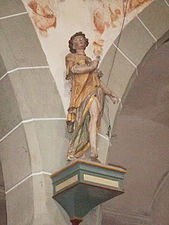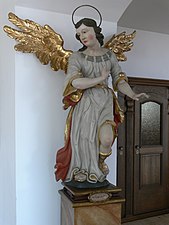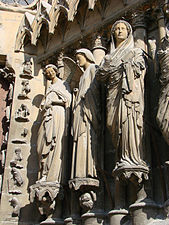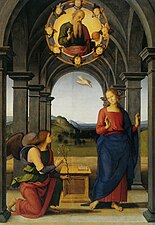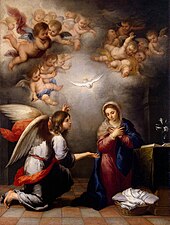Gabriel (Archangel)
Gabriel (in German "Mann / Kraft / Held Gottes" as a translation of Hebrew גַּבְרִיאֵל (Gavri-El, "My (e) husband / hero / strength is God")) is considered one of the archangels and is in the Bible in the book Daniel ( Dan 8.16 ELB , Dan 9.21 ELB ) as well as in the Gospel according to Luke ( Lk 1.19 ELB and Lk 1.26 ELB ) mentioned. He is considered to be an explainer of visions and a messenger of God . According to the Christian and Jewish view, it can also be interpreted as superior to the cherubim and seraphim . In Mormon theology , the Archangel Gabriel was embodied in Noah , the builder of the ark . Gabriel (arab.جبريل, DMG Ǧibrīl ) also plays an important role in Islam by conveying the revelations to Mohammed .
Christianity
Bible

In the Bible his name appears first in the book of Daniel , where he interprets the vision of the ram and the billy goat ( Dan 8,16 ELB ) and the prophecy about the duration and end of the exile ( Dan 9,21 ELB ). His role is that of a messenger of God, but outwardly he is described later:
- “And I lifted up my eyes and saw: and, behold, there was a man clad in linen, and his hips were girded with gold from Ufas. And his body was like a turquoise and his face like the appearance of lightning. And his eyes were like torches of fire, and his arms were like the sight of smooth bronze. And the sound of his words was like the sound of a crowd. But only I, Daniel, saw the apparition alone. And there was no strength in me, and the color of my face changed to the point of disfigurement, and I did not retain any strength. And I heard the sound of his words. And when I heard the sound of his words, I lay numb on my face, with my face to the earth. "(Daniel, 10: 5-9)
Gabriel is described as the angel who fights for the people of Israel against the angels to whom the other peoples are subordinate:
- “Did you see why I came to you? But now I am returning to fight the Prince of Persia. And when I have finished with him, see, the king of Greece will come ”(Daniel 10:20)
In the New Testament, the Gospel of Luke reports the preaching of John:
- “An angel of the Lord appeared to him and stood at the right hand of the incense altar. And when Zacharias saw him, he was dismayed and frightened. But the angel said to him, Do not be afraid, Zacharias. For your supplication has been heard, and your wife Elizabeth will bear you a son, and you shall call his name John. (Luk 1,11-113) (...) the angel answered and said to him: I am Gabriel, who stands before God, and I was sent to speak to you and to preach the good news to you. "(Luk 1 , 19)
Likewise, the birth of Jesus is announced by Gabriel:
- “In the sixth month, however, the angel Gabriel was sent by God to a city in Galia, called Nazareth, to a virgin who was betrothed to a man named Joseph, of the house of David, and the virgin's name was Mary. And he came in to her and said, Greetings, those who are favored. The Lord is with you. But she was taken aback by this word and wondered what kind of greeting it was. And the angel said to her, Do not be afraid, Mary! for you have found favor with God. And, behold, you will conceive and give birth to a son, and you are to call his name Jesus. He will be great, and will be called the Son of the Most High, and the Lord God will give him the throne of his father David. And he will rule over the house of Jacob forever and there will be no end to his kingdom ”(Luk 1: 26–33)
Christian art
In art, Gabriel was often depicted with masculine, often androgynous and often feminine features and features. His attribute is the lily , with which he is represented when the birth of Jesus is proclaimed to Mary . The lily is interpreted as the symbol for the virginity of Mary (Madonna lily). Occasionally, however, he is also represented as an angelus interpres with a scroll, a trumpet or simply with a raised index finger .
Statues
Statue of the Archangel Gabriel, Bermatingen
Statue of the Archangel Gabriel, Waldburg
Gabriel on the facade of Reims Cathedral
Statue on Heroes' Square (Budapest)
Depiction on pictures of Mary
Annunciation by Mariotto Albertinelli , 15th century
Annunciation by Pietro Perugino , 1489
Annunciation by Leonardo da Vinci , circa 1472–1475
Annunciation by Botticelli , 1490
Annunciation by Murillo , 1655
Remembrance day
His feast day is September 29th (Roman Catholic: "Archangel Festival St. Michael, St. Gabriel, St. Rafael"; Protestant: "Day of the Archangel Michael and all angels"). Until 1970 Gabriel had his own festival in the Catholic Church on March 24th .
Archangel Gabriel is, among other things, the patron saint of the post office , philately , telecommunications, deliverers , garbage collectors , diplomats , radio announcers and the telecommunications troops of the German army .
Old Testament pseudepigraphs
In the Ethiopian Book of Enoch , Gabriel is mentioned in chapter 20.7 next to Uriel (20.2), Raphael (20.3), Raguël (20.4), Michael (20.5) and Sarakael (20.6) - in some manuscripts is still called Remiel (20.8) - counted among the (seven) highest angels. There it says about him: "Gabriel is the name of a sixth of the holy angels, who is appointed over Paradise, the serpents and the Kerube" ( 1 Enoch 20: 7 ). The seven number of the highest angels is for the Ethiopian Book of Enoch in chapter 90.21 f. guaranteed.
Judaism
In rabbinic sources it is said of Gabriel, it consists entirely of fire, while Michael all consisted of snow. Gabriel and Michael are assigned the metals gold and silver accordingly. The attributes assigned to them in Judaism differ from those assigned to them in later Christian mythology , in which Michael is sometimes associated with the sun and Gabriel with the moon.
In Jewish tradition, the two angels who went to Sodom and Gomorrah were Michael and Gabriel (Genesis 19): Michael to save Lot , Gabriel to destroy the city.
In the Talmud , after Michael, he is considered the greatest of the “prince angels”, recording and executing the judgment of God, defending and protecting Israel .
Islam
In Islam plays Gabriel, in Arabic Jibrīl (جبريل, DMG Ǧibrīl ) or Jabrāʾīl (جبرائيل, DMG Ǧabrāʾīl ), a central role as a transmitter of the revelation to the Prophet Mohammed .
introduction
In the Koran Gabriel is only mentioned explicitly in three verses ( Sura 2 : 97, 98 and Surah 66 : 4). It is noticeable that they are all assigned to the medical time . From this, Abraham Katsh concluded that it was only at this time that the idea of Gabriel as a transmitter of the Koran was introduced into Islam. The reason that Gabriel was chosen of all people, he assumed that he played a prominent role in the Jewish traditions about Abraham and Moses .
From the two verses 2:97, 98 it can be seen, however, that the introduction of the figure of Gabriel met with opposition. In the translation of Hartmut Bobzins, they read as follows: “Say: Whoever is hostile to Gabriel - because, behold, it is he who sent him down into your heart, with God's permission, confirming what was before him, as correct guidance and as good news for the believers. If one is hostile to God and to his angels, to his messengers, Gabriel and Michael, then God is also to be hostile to the unbelievers. ”The Qur'an comments explain that these verses were revealed in connection with Muhammad's dispute with the Jews in Medina . They are said to have asked Mohammed who the angel was who brought him the revelations. When Mohammed replied that this was Gabriel, the friend ( wali ) of every prophet, the Jews said that they could not recognize him then because their friend was the angel Michael , while Gabriel was their enemy. The prophet is said to have replied that both angels were servants of God and therefore could not be enemies. Finally, Sura 2:97 f. revealed. According to another version of the story, it was Umar ibn al-Khattab who learned of the Jewish views about Gabriel while visiting a synagogue in Medina.

Islamic lore
According to the later Islamic tradition, Gabriel was not only introduced in the Medieval times, but was rather the transmitter of the revelation to Mohammed from the beginning. Accordingly, many other statements in the Koran were related to Gabriel. So he should, for example, with the "reliable spirit" (الروح الأمين / ar-rūḥ al-amīn ), who gave the heart of Muhammad the Koranic revelation in clear Arabic language ( Sura 26 : 193–195), as well as the “Spirit of Holiness” or “ Holy Spirit ” (روح القدس / Rūḥ al-Qudus ), who has revealed the Koran from God with the truth ( Sura 16 : 102). He is also said to have guided Mohammed on his heavenly journey through paradise and hell. After all, the so-called Gabriel Hadith plays a central role in Islamic doctrine of duty . The doctrine of the Five Pillars of Islam is based on him .
According to the Shiite view, Gabriel was the one who is said to have said to Imam Ali : Lā saifa illā dhū l-faqār wa-lā fatā illā ʿAlīyun. This means something like: "There is no hero more heroic than Ali and no sword except Dhū l-faqār ." He is said to have led the angels into the battle of Badr on his horse Haizum .
In film and fiction
In the film Constantine , Gabriel is portrayed by the actress Tilda Swinton . In the film God's Army - The last battle (English original title: The Prophecy ) and the two sequels Gabriel is played by the actor Christopher Walken . This film shows the archangel Gabriel and various other angels waging an epic final battle for the kingdom of heaven. In the series Supernatural , Gabriel, played by Richard Speight Jr. , falls from the sky. Gabriel also plays a central role in the novel The Satanic Verses by Salman Rushdie . In the miniseries Good Omens Gabriel is played by actor Jon Hamm .
See also
- Gabriel as a first name
- Ave Maria
- English greeting
- Gabriel Church
- Mission House Saint Gabriel
- Archangel Gabriel-Stolln , treasure trove in the Johanngeorgenstadt mountain area in the Saxon Ore Mountains
literature
- General
- Gerhard Bellinger : Knaurs Lexikon der Mythologie . Droemer Knaur, Munich 2000. 157, 327, 346, 485-487, ISBN 3-426-66415-1 .
- John J. Collins: Gabriel , in: K. van der Toorn; B. Becking; Pieter W. van der Horst (Ed.): Dictionary of Deities and Demons in the Bible. Leiden, Boston, Cologne, 2 1999, 338–339, ISBN 0-8028-2491-9 .
- Heinrich Krauss: Small encyclopedia of angels. From Ariel to Zebaoth. Beck, Munich, 2004, pp. 73 f., 119-121, ISBN 978-3-406-45951-1 .
- Islam
- J. Pedersen: Dj abrāʾīl In: The Encyclopaedia of Islam. New Edition . Vol. II, pp. 362b-364a.
- Abraham Katsh: Judaism in Islam. Biblical and Talmudic Backgrounds of the Koran and its commentaries. New York 1954, pp. 85-90.
- Gisela Webb: Gabriel. In: Encyclopedia of the Qur'an. EGG. Brill Publishers, Leiden 2002, ISBN 90-04-12035-1 .
Web links
- Icons of the Archangel Gabriel
- Hans Klein, Christoph Rösel: Gabriel. In: Michaela Bauks, Klaus Koenen, Stefan Alkier (Hrsg.): The scientific Bibellexikon im Internet (WiBiLex), Stuttgart 2006 ff., Accessed on May 28, 2012.
Individual evidence
- ↑ Adam's Religion. denversnuffer.com, December 21, 2015, accessed on August 26, 2017 .
- ↑ Elias and Elijah in the Kirtland Temple. www.fairmormon.org, 2017, accessed August 26, 2017 .
- ↑ See Katsh 87-89.
- ↑ See Pedersen 363a.
- ↑ Cf. Katsh 85 f.


